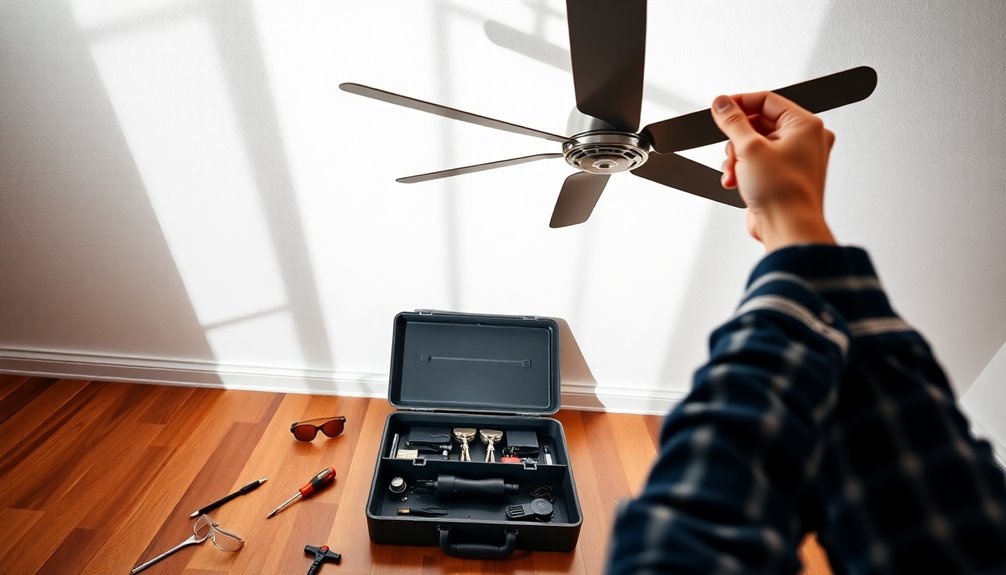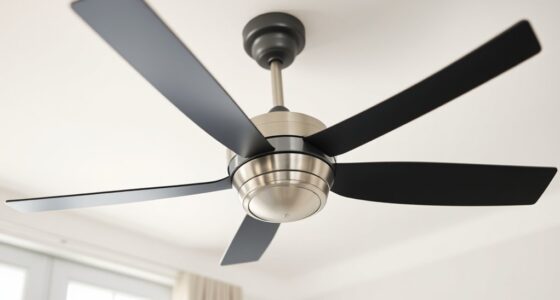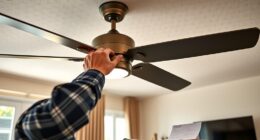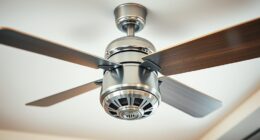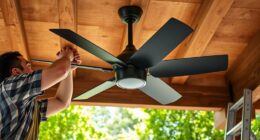Yes, you can replace a ceiling fan yourself as long as you have the right tools and some basic skills. Make certain you gather a sturdy ladder, screwdrivers, a voltage tester, and safety goggles. Before starting, always turn off the power at the circuit breaker to avoid any electrical hazards. Follow a step-by-step guide to securely mount and wire the fan. It's also wise to check local codes to guarantee compliance. If you run into complex wiring issues or feel uncomfortable, don't hesitate to call a professional. There's plenty more to discover about installation and maintenance along the way.
Key Takeaways
- Yes, you can replace a ceiling fan yourself if you have the right tools and follow safety precautions.
- Ensure the power is turned off and use a voltage tester to confirm no live wires are present.
- Follow the manufacturer's installation guide for proper mounting and wiring of the new fan.
- Regular maintenance, such as cleaning and inspecting, is essential for safe and efficient operation.
- If you encounter complex wiring or height issues, consider hiring a professional to ensure safety and compliance.
Benefits of Ceiling Fans

When it comes to keeping your home comfortable year-round, ceiling fans offer numerous benefits that can enhance your living space.
These versatile fixtures can effectively cool a room in summer by creating a wind-chill effect, making it feel several degrees cooler without considerably increasing energy costs. In winter, running a ceiling fan in reverse helps distribute warm air that naturally rises, improving HVAC efficiency and maintaining a cozy atmosphere.
By using ceiling fans in tandem with your heating and cooling systems, you can potentially lower your utility bills by up to 30%. This energy-efficient ceiling fan strategy not only saves you money but also contributes to a more sustainable lifestyle.
Improved air circulation is another advantage, making ceiling fans ideal for spaces with fireplaces or space heaters.
Choosing an energy-efficient ceiling fan model further minimizes electricity consumption while ensuring a comfortable indoor environment.
Tools and Materials Needed

Replacing a ceiling fan yourself requires a few fundamental tools and materials to guarantee the job goes smoothly.
First, you'll need a sturdy ladder to safely reach the ceiling height while you work. A screwdriver is essential—having both flathead and Phillips types will help you secure brackets and connect wires efficiently.
Before starting, grab a voltage tester to verify the power is off. This step is critical for your safety, so don't skip it.
Once you're ready to connect the wiring, wire strippers or cutters will be necessary to prepare the wires for secure connections. Make sure the ceiling box is properly installed and can support the weight of your new fan.
Lastly, don't forget to wear safety goggles. They're important for protecting your eyes from any debris or sharp edges as you work overhead.
With these tools and materials at hand, you'll be well-equipped to tackle your ceiling fan replacement project confidently. Being prepared guarantees a smoother installation process and helps you avoid any unnecessary setbacks.
Safety Precautions Before Starting

Before you begin your ceiling fan replacement, it's vital to take safety precautions seriously. Start by turning off power at the circuit breaker, not just at the wall switch. This guarantees that you're completely safe during the electrical work.
Once you've done that, grab a voltage tester to confirm the power is off before you handle any wires. This step is important to prevent electrical shock.
Don't forget to wear safety goggles to protect your eyes from any debris that might fall during the installation process. As you work on the ceiling fan, make sure your ladder is stable and positioned on a flat surface to avoid falls. A secure ladder is just as important as securing the mounting bracket for the fan.
Lastly, verify that you're following all local codes and regulations regarding electrical work. Adhering to these guidelines not only keeps you safe but also guarantees your installation meets legal standards.
Step-by-Step Installation Guide

Before you start the installation, gather the necessary tools like a screwdriver, wire nuts, and a voltage tester. It's vital to follow safety precautions, like turning off the power and checking for any live wires. With everything in place, you're ready to tackle the step-by-step process of replacing your ceiling fan. Regular maintenance can prevent dangerous situations that may arise from improper installation or faulty components. Additionally, ensuring proper heat pump maintenance can enhance the overall safety and efficiency of your home's electrical systems. Furthermore, investing in advanced cleaning features can improve hygiene in your home environment. It's also important to consider home security systems that can monitor your home for potential hazards during the installation process. Installing a ceiling fan can be straightforward, especially when you have the right tools and follow best practices for safety.
Tools Needed for Installation
When tackling the installation of a ceiling fan, gathering the right tools can make all the difference in ensuring a smooth process. Start with a sturdy ladder, allowing you to comfortably reach your ceiling. A reliable screwdriver is essential for securing brackets and wiring, so have a Phillips head and a flathead on hand.
Safety is paramount, so don't forget a voltage tester to confirm the power is off before you touch any wires. Wire cutters or strippers are also necessary for preparing wire connections; they'll help you cleanly strip the ends of wires for secure connections.
Pliers will come in handy for twisting and securing those connections, ensuring everything is tight and safe. Additionally, keep some electrical tape nearby. You'll need it to secure wire connections and prevent any exposed wires, which adds an extra layer of safety during and after installation.
Finally, consider wearing safety goggles to protect your eyes from debris as you work, especially if you're dealing with older fixtures. With these tools ready, you'll be well-equipped to tackle your ceiling fan installation confidently.
Safety Precautions to Follow
Tackling the installation of a ceiling fan requires careful attention to safety precautions. By following these steps, you can guarantee a safe and effective installation process.
| Step | Action | Purpose |
|---|---|---|
| 1. Turn Off Power | Switch off the circuit breaker | Prevents electrical shock |
| 2. Use Voltage Tester | Confirm no power in wires | Guarantees safety before handling |
| 3. Wear Safety Goggles | Protect your eyes from debris | Prevents injury during installation |
| 4. Use Insulated Tools | Minimize shock risk | Guarantees safe electrical connections |
| 5. Secure Stable Ladder | Position ladder securely | Prevents falls while working |
Always remember to follow the manufacturer's instructions for your specific fan model. This guarantees that all electrical connections are made correctly and safely. With these precautions in mind, you can tackle your ceiling fan installation with confidence. Prioritize safety at every step to prevent accidents and guarantee a smooth installation process.
Troubleshooting Common Issues

If your ceiling fan's wobbling, it's time to check for loose screws and blade alignment.
You might also face electrical issues, like flickering lights or a fan that won't operate at all.
Let's explore how to diagnose these common problems and get your fan running smoothly again.
Wobbling Fan Solutions
Experiencing a wobbling ceiling fan can be frustrating, but addressing the issue is often straightforward. Start by checking your ceiling fan installation. Make sure all mounting screws are securely tightened. Loose screws can lead to wobbling, so be diligent in attaching the fan properly.
Next, use a level tool to check for alignment. An unbalanced fan might need some adjustments or shimming to correct its position. Inspect the fan blades for any warping or damage, as uneven blades can disrupt airflow and cause wobbling. If you find any damaged blades, it's best to replace them.
Ensure that all blades are at the same height from the ceiling. Variations in blade height can lead to an imbalance and subsequent wobbling.
If your fan continues to wobble even after these adjustments, consider using a fan balancing kit. This kit typically includes weights that can be attached to the blades to help achieve balance.
Electrical Issues Diagnosis
Even after addressing wobbling issues, you might encounter other problems that prevent your ceiling fan from functioning properly.
Start by checking the power supply; verify the circuit breaker is on and the light switch is in the "on" position. If the fan still isn't operating, inspect the existing wiring connections. Loose wiring can cause flickering lights or intermittent operation, so tighten any loose connections.
If you hear strange noises like grinding or rattling, it could signal worn bearings or loose screws. Inspect the fan thoroughly for any loose components and tighten them as necessary.
If your fan only works at one speed or doesn't respond to the remote control, check the remote's battery first. Then, verify the receiver inside the fan is properly wired and functional.
If you find that the wiring is damaged or you're unsure about any connections, it's wise to consult an electrician. They can help you replace or repair any faulty wiring to verify your fan operates safely and efficiently.
Additionally, ensuring that your fan is properly calibrated for optimal performance can prevent electrical issues in the long run.
With these troubleshooting tips, you'll be well on your way to diagnosing any electrical issues with your ceiling fan.
When to Hire a Professional

Deciding whether to tackle a ceiling fan installation yourself or to call in a professional can be a tough choice. If you lack experience with electrical work or feel uncertain about the installation process, it's wise to hire a professional. They guarantee safety and compliance with local codes, which can save you from potential hazards.
Here are some scenarios when you might need an electrician:
| When to Hire a Professional | Why It Matters |
|---|---|
| Existing ceiling box isn't fan-rated | Prevents accidents and guarantees safety |
| Complex wiring issues | Avoids electrical hazards |
| Installation involves heights | Reduces risk of falls and injuries |
| Local regulations require licensed pros | Guarantees compliance with local laws |
If you notice any problems with your existing ceiling box or wiring, a local electrician can assess and correct issues safely. Additionally, professional electricians often provide warranties on their work, giving you peace of mind that the installation will be done correctly. Ultimately, if you're unsure, it's better to hire a professional to guarantee everything is done right and safely. Furthermore, ensuring your installation meets local codes is critical for safe operation and functionality.
Maintenance Tips for Ceiling Fans

To keep your ceiling fan running smoothly and efficiently, regular maintenance is vital. Start by dusting and cleaning the blades at least once a month. This helps maintain ideal airflow, as dust buildup can greatly impede performance.
Every few months, inspect and tighten all screws and connections to prevent wobbling and guarantee stability during operation.
Don't forget to reverse the fan direction seasonally. In summer, run it counterclockwise for a rejuvenating breeze, while in winter, switch it to clockwise to circulate warm air effectively.
Additionally, check the fan's motor and electrical connections for signs of wear or damage at least twice a year. This precaution can prevent potential electrical hazards and assure safe operation.
Lastly, consider scheduling professional inspections every few years. These inspections can assess the fan's overall condition and address any emerging issues that may arise from regular use. Regular maintenance also includes monitoring air quality indicators to ensure the environment is conducive to optimal fan performance.
Frequently Asked Questions
Is It Safe to Replace a Ceiling Fan Yourself?
You might think it's safe to replace a ceiling fan yourself, but there are risks involved.
First, you need to turn off the power at the circuit breaker to avoid electrical shock. If you're inexperienced, it's better to hire a licensed electrician, as improper installation can lead to safety hazards like fires.
Always check that your electrical box is rated for ceiling fans and follow the manufacturer's instructions to guarantee a safe setup.
Is It Difficult to Replace a Ceiling Fan?
Isn't it intimidating to think about replacing a ceiling fan? It can definitely be tricky, especially if you're not familiar with electrical work.
You'll need to handle wiring and guarantee the fan's securely mounted. If your ceiling's high, a ladder adds another layer of challenge.
Plus, you might've to check if your electrical box can support the new fan's weight. Overall, it can be more complicated than it seems at first glance.
Do You Need an Electrician to Replace an Existing Ceiling Fan?
Yes, you need an electrician to replace an existing ceiling fan, especially in New South Wales.
DIY electrical work is illegal there, so hiring a licensed electrician is essential. They'll guarantee your new fan is installed safely and complies with local regulations.
Plus, they can check your wiring and junction box to prevent hazards. By doing this, you'll avoid potential issues with insurance and enjoy peace of mind from a professional installation.
Can You DIY Replace a Ceiling Fan?
Sure, you can totally DIY that ceiling fan, if you're feeling like a home improvement superhero!
Just remember, wielding tools doesn't magically make you an electrician. Make sure you turn off the power first—safety first, right?
Grab your trusty ladder and some basic tools, and check those wires. If it all feels like a tangled mess, don't hesitate to call in a pro.
It's better to avoid a shocking experience!
Conclusion
In the dance of home improvement, replacing a ceiling fan can be a rewarding twirl, adding a breeze of comfort to your space. With the right tools and a touch of caution, you can take the lead in this project. However, if you find yourself tangled in wires or uncertainty, don't hesitate to call in a professional. After all, it's better to have a smooth performance than to stumble on stage. Enjoy your newfound airflow!
